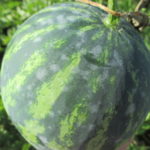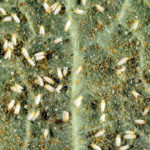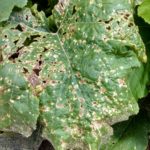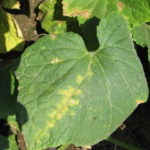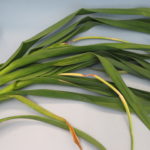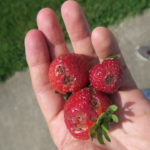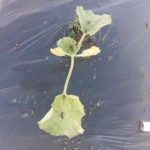While cantaloupe and pumpkin growers are used to combating powdery mildew in Indiana, watermelon growers may not be familiar with the disease. Occasionally, I observe this disease on watermelon as well. If left uncontrolled, this disease can cause loss of foliage, loss of yield and lower quality fruit. This article will discuss the biology and[Read More…]
Here in Indiana, whitefly problems are rare, but when encountered it is most often in protected ag production (greenhouse or high tunnel) and less often in the field. However, this is the time of year that you may be seeing them in either environment. Whiteflies are not true flies, but rather Hemipteran insects, more closely[Read More…]
I have observed this disease in scattered commercial pumpkin and squash fields across Indiana. Symptoms: Bacterial spot causes ⅛-¼ inch angular leaf lesions that are white to light brown in color (Figure 1). These leaf lesions may be accompanied by yellowing (chlorosis). The more important symptom are the lesions on fruit that are scabby to[Read More…]
This article is modified from Darcy Telenko’s article about field corn in a recent Purdue Pest and Crop newsletter. Southern rust of corn is normally a disease of tropical areas. During summer months, however, the fungus which causes southern rust, Puccinia polysora, may move into Indiana or other Midwestern states. Southern rust has officially been confirmed[Read More…]
Cucurbit downy mildew has been observed on cucumber in the southwest corner of Michigan, just across the border from La Porte County and LaGrange Counties, Indiana. All cucurbit growers in Indiana should be scouting for downy mildew. Cucurbit growers in northern Indiana should be managing for downy mildew. The organism that causes downy mildew of[Read More…]
Vegetable growers are used to scouting for pests such as spider mites and aphids. Growers have come to recognize the yellow leaves caused by spider mites and the curled leaves caused by aphids. Growers understand that even after spider mites and aphids are dead, the symptoms of the damage may remain on the affected leaves.[Read More…]
Earlier this summer, sunken lesions were observed on garlic scapes on a small farm in east central Indiana. Lesions started out a cream or tan color (Figure 1), however under rainy or humid conditions, spore production caused lesions to turn orange (Figure 2). Larger lesions resulted in the collapse of the scapes. It is estimated[Read More…]
The 2019 production season started with above-normal rains. The wet conditions affected agriculture production, including watermelon and cantaloupe. In this article, we will review some of the watermelon and cantaloupe problems that are often associated with wet conditions. Manganese toxicity– This nutrient disorder occurs more often on cantaloupe that is grown in soils with pH[Read More…]
At the Southwest Purdue Ag Center, we are studying annual strawberry production on plastic mulch. Our hope is to gather information on the best methods and varieties to use for annual strawberry production in Indiana. As we learn about insect and disease problems, we will pass this information on to producers. This article is about[Read More…]
I know this may not come as a surprise to most of you, but it is rare that we get to observe the effectiveness of insecticides in such a dramatic way as we encountered when visiting a melon grower in southern IN recently. And in this case, the decision to apply an insecticide at transplant[Read More…]

